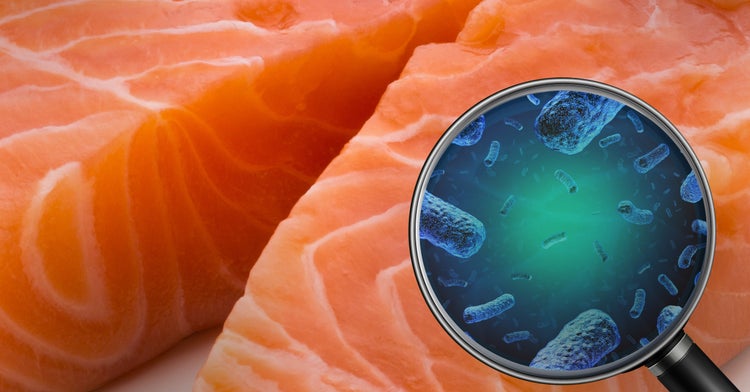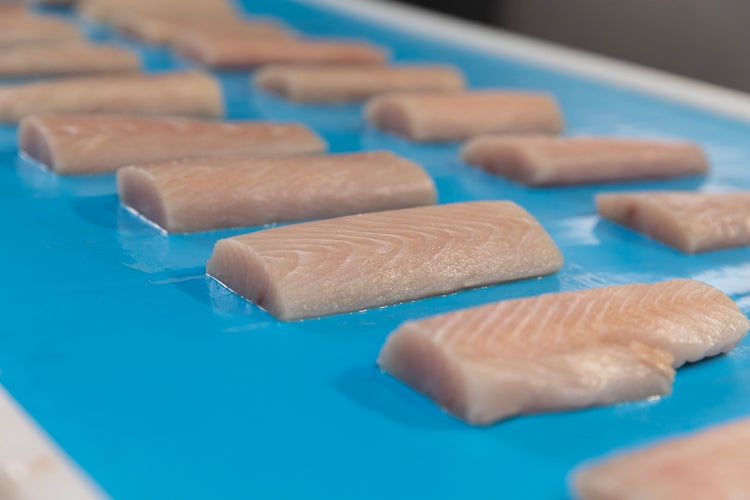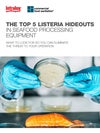Preventing Listeria in Seafood Processing Plants
Where to begin in the search to identify this persistent threat to your facility
- Insights
- December 28, 2022

“Every night, there’s an army of bacteria that want to come into your plant, and probably do.”
Joe Stout—Commercial Food Sanitation Founder and Senior Advisor—knows how prevalent and dangerous Listeria monocytogenes can be for seafood processing facilities.
Manufacturers of every fishery subspecies fight this battle daily. The enemy is invisible, hardy, adept at hiding, and difficult to eliminate.
What should you pay attention to, and what measures can you take, to expose this dangerous organism so you can take steps to prevent it from growing and contaminating your product?
Here are some questions to ask about your facility, conveyors, practices, and team members so you can develop a fighting chance against Listeria in your seafood plant. But first…
Why is Listeria control particularly challenging in seafood facilities?
From the time your product is fished out of the water, it’s met with a series of conditions that prompt Listeria to grow. These include:
- Harvesting: Once caught, your product may be collected into bins with other fish or pushed around with shovels on the boat. If proper sanitation is lacking on the vessel, cross-contamination can occur.
- Moisture: Bacteria do very well in wet conditions. And there is an ample supply of water in a seafood plant.
- Temperature: While the low temperatures of seafood processing facilities stifle some bacteria—such as Salmonella and E. coli—Listeria can thrive in cold conditions. In fact, few organisms compete well with Listeria in cold to freezing environments.

Inspect your food contact surfaces. Hygienic modular plastic and ThermoDrive belts from Intralox are nonporous, nonabsorbent, and easy to clean.
Is the equipment in your plant hygienically designed?
Fabric belts. Closed hinges. Sandwich joints. Hollow rollers. These are just some of the niches where Listeria can grow and become a source of cross contamination in seafood. “For example, if your equipment has sharp corners where chemicals and light can’t reach, it could be a point of contamination where the colony can grow,” says Stout.
Conveyors, belts, and equipment designed with hygienic principles in mind are more open, nonporous, and have fewer niches. That means fewer places for Listeria to hide and multiply.
Do you have an effective environmental monitoring program in place?
While you may be able to observe your plant’s conditions, you can’t see bacteria. You wouldn’t be able to see a million of them. If Listeria is present in your facility, you must locate it. That’s what makes environmental monitoring so critical.
“The plants that swab aggressively,” says Stout, “are the ones that will find the organism. I like to say you have to ‘swab with authority’ so that you get to know as much about your environment as possible.”
If you can’t see it and can’t reach it, then you can’t effectively sample or clean it. It’s a potential problem, and a clear indication of poor hygienic design.
Commercial Food Sanitation Founder and Senior Adviser
What is your sanitation strategy?
Is your cleaning process organized to be effective? Determine the best sequence for cleaning an area to prevent recleans and cross-contamination risk. Also, it’s important to provide your team with the tools they need to clean better and faster.
To manage the niche points of legacy equipment, we recommend establishing a periodic frequency to perform disassembly and deep cleaning. This will help you reach areas where colonies of Listeria can be protected from the normal cleaning process.
Have you considered introducing automation to help reduce cross-contamination?
Hiring labor is seen as an alternative to investing in technology that will automate plant processes. But the right equipment can not only add value (such as increased throughput), but it can also remove hazards, including opportunities for cross-contamination.
“Automation reduces the risk of cross-contamination caused by personnel not precisely following Good Manufacturing Practices (GMPs),” explains Stout. Plant personnel can spread germs by performing unclean actions, such as picking something up off the floor and going right back to touching the product. But pieces of equipment don’t introduce these kinds of cross-contamination risks.
Is there a team approach to food safety and pathogen control at your facility?
It’s hard to be on your game every day. But that’s what it takes to fight an organism that can hide and multiply the way Listeria does in seafood processing plants worldwide.
No one person or single team can be expected to do it alone. You may have heard the term “culture of food safety” before. What does that mean? Your plant should have effective programs in place that are executed well so it’s routinely producing safe food. Stout takes that idea further. “I like to call it a culture of caring,” he says. “Everyone in the plant is engaged and cares about doing the right thing to produce safe food.”
Intralox Team Tip: Use sanitary blades in your plant. Sponge squeegees rarely dry out, resulting in a constant presence of moisture which acts like a magnet for Listeria.
Eliminating Listeria is considered one of the most frustrating tasks that a food safety professional has.
A wet, cold seafood facility using closed equipment with niche areas and a less-than-vigilant approach to pathogen control is giving the organism everything it needs to thrive.
With the right belting, equipment, and service partners, you can arm your plant with everything it needs to win the battle against Listeria.
Not sure where to begin?
Download our guide, "The Top 5 Listeria Hideouts in Seafood Processing Equipment," created by the experts at Intralox and Commercial Food Sanitation.

